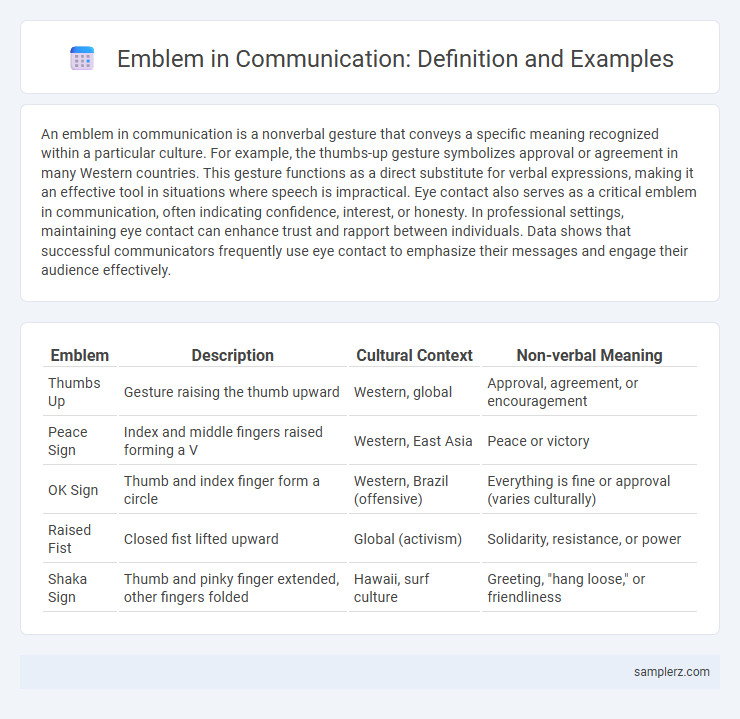An emblem in communication is a nonverbal gesture that conveys a specific meaning recognized within a particular culture. For example, the thumbs-up gesture symbolizes approval or agreement in many Western countries. This gesture functions as a direct substitute for verbal expressions, making it an effective tool in situations where speech is impractical. Eye contact also serves as a critical emblem in communication, often indicating confidence, interest, or honesty. In professional settings, maintaining eye contact can enhance trust and rapport between individuals. Data shows that successful communicators frequently use eye contact to emphasize their messages and engage their audience effectively.
Table of Comparison
| Emblem | Description | Cultural Context | Non-verbal Meaning |
|---|---|---|---|
| Thumbs Up | Gesture raising the thumb upward | Western, global | Approval, agreement, or encouragement |
| Peace Sign | Index and middle fingers raised forming a V | Western, East Asia | Peace or victory |
| OK Sign | Thumb and index finger form a circle | Western, Brazil (offensive) | Everything is fine or approval (varies culturally) |
| Raised Fist | Closed fist lifted upward | Global (activism) | Solidarity, resistance, or power |
| Shaka Sign | Thumb and pinky finger extended, other fingers folded | Hawaii, surf culture | Greeting, "hang loose," or friendliness |
Understanding Emblems in Communication
Emblems in communication are nonverbal gestures with specific, culturally understood meanings, such as the thumbs-up sign indicating approval or agreement. These gestures convey messages independently of spoken language, enhancing clarity and efficiency in interactions. Recognizing and correctly interpreting emblems is crucial for effective cross-cultural communication and reducing misunderstandings.
Defining Emblems: A Nonverbal Language
Emblems are culturally specific nonverbal gestures that convey precise meanings without spoken words, such as the thumbs-up sign for approval in many Western cultures. These gestures function as a nonverbal language, allowing individuals to communicate efficiently across noisy environments or when speech is not possible. Emblems serve as clear, universally understood signals within their cultural contexts, facilitating instant comprehension and reducing misunderstandings in communication.
Cultural Variations of Emblems
Emblems in communication, such as the thumbs-up gesture, vary significantly across cultures, symbolizing approval in the United States but considered offensive in parts of the Middle East. The "OK" hand sign conveys agreement in many Western countries but can be interpreted as a vulgar insult in Brazil and Turkey. Understanding these cultural variations is essential for effective intercultural communication and avoiding misunderstandings.
Common Examples of Emblems Worldwide
Common examples of emblems in communication include the thumbs-up gesture, symbolizing approval or agreement in many cultures, and the peace sign, widely recognized as a symbol of harmony and non-violence. The OK hand gesture conveys affirmation, although its meaning can vary across regions, while the nodding of the head typically signals agreement universally. These emblematic gestures serve as nonverbal shortcuts that convey clear, culturally embedded messages without spoken words.
Emblems in Professional Settings
In professional settings, emblems such as the thumbs-up gesture symbolize approval or agreement without verbal communication. The nod of the head often signifies acknowledgment or affirmation during meetings, streamlining interactions. These culturally recognized emblems enhance efficiency by conveying clear, concise messages in workplace communication.
The Role of Emblems in Public Speaking
Emblems in public speaking serve as powerful nonverbal symbols that convey specific meanings without words, such as the "thumbs up" gesture indicating approval. These culturally recognized signs enhance message clarity and audience engagement by reinforcing verbal content. Effective speakers use emblems to emphasize key points and create memorable communication moments.
Impact of Emblems on Interpersonal Communication
Emblems such as the thumbs-up gesture or the peace sign convey specific meanings without spoken words, enhancing clarity and efficiency in interpersonal communication. These culturally recognized symbols reduce misunderstandings by providing immediate visual cues that express agreement, approval, or goodwill. The impact of emblems lies in their ability to strengthen nonverbal messages, facilitating quicker emotional connection and smoother interactions between individuals.
Misunderstandings Caused by Emblems
Emblems in communication, such as the thumbs-up gesture, can cause misunderstandings when their meanings vary across cultures; for instance, while it signals approval in the United States, it is considered offensive in parts of the Middle East. Misinterpretation of these nonverbal symbols often leads to confusion or unintended conflict during cross-cultural interactions. Recognizing the cultural context of emblems is essential to avoid communication breakdowns and enhance mutual understanding.
Emblems in Digital and Visual Media
Emblems in digital and visual media function as powerful nonverbal symbols that convey specific messages or cultural meanings instantly. Common examples include the "thumbs up" emoji, which universally signifies approval or agreement, and corporate logos like the Apple logo, which embody brand identity and values without words. These emblems enhance communication efficiency by transcending language barriers and providing clear, immediate understanding in online interactions and digital marketing campaigns.
Enhancing Communication with Emblems
Emblems such as the thumbs-up gesture or the peace sign serve as powerful nonverbal symbols that convey specific messages universally without spoken words. These culturally recognized gestures enhance communication by providing clarity and reinforcing spoken language in face-to-face interactions. Utilizing emblems effectively reduces misunderstandings and strengthens interpersonal connections across diverse cultural contexts.

example of emblem in communication Infographic
 samplerz.com
samplerz.com